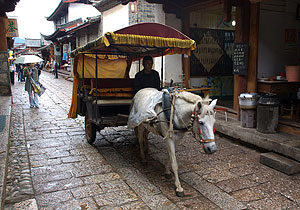Shuhe Old Town

Located about 4km north of Lijiang, Shuhe village is home to the local Naxi people. When Lijiang was selected for protection as a world heritage site, Shuhe was also included. Shuhe or "Shaowu" in the Naxi language, means the village at the foot of the high hill. It is also called Dragon Spring Village after a spring that rises nearby.
The village has a history of over a thousand years and was an important trading place on the old tea-horse route between Tibet and Yunnan. Tea and horse trade has always been good and kept the village thriving. Shuhe is also famous for its cobblers who can make leather goods to rival the best in the world.
Shuhe Square Market is in the middle of the village and the liveliest area. North of the square is Jiuding Dragon Pool which is held as a holy place in Naxi beliefs and Longquan Temple (Dragon Spring Temple) was built beside it in honor of the founders of the cobbler handicraft.
Buildings in the village are of a more traditional and natural design than even those in Lijiang, because they are made from the stones of the areas mountains. Also the town is less developed than Lijiang and the structures are less affected.
Some popular attractions include Dajue Palace which is part of the Shuhe Yard buildings of the Mu family in the Ming Dynasty and contains 6 important frescos. The Museum of Tea and Horses describes the history of the ancient trade road and the Dongba Palace displays the Dongba culture including dancing and singing performances.